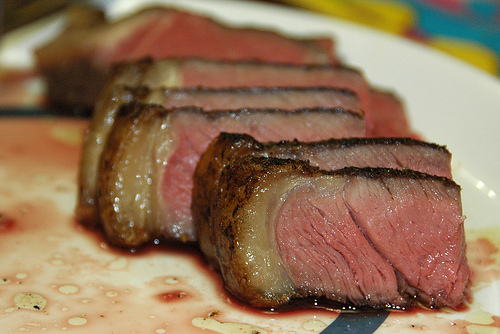Sous-vide: Cutting edge food technology

Sous-vide seems pretty strange on the face of it. Put a steak in a ziplock bag, soak it in a warm water bath for 72 hours, then eat that steak? Bizarre! But it works, and it’s delicious.
Sous-vide was developed in France in the 1970s, and popularized by famed chef Thomas Keller in the 1990s at the French Laundry. He published a definitive treatise on the technique in 2008, which brought awareness of the technique to the food-loving public. Sous-vide is probably best known for its use with beef and pork, but enterprising chefs have also turned the technique to fish, chicken and eggs (which come out of the cooker with a creamy texture often described as “pudding-like”).
If you have ever studied (deliberately or through real-world practice) “the art of the slow roast,” you already know the guiding principle behind sous-vide. Take a giant, cheap cut of meat, like a pork shoulder or a beef butt roast. Cook it low and slow: say 300 degrees, an hour per pound. The lower heat and the longer cooking time conspire to soften the meat, allowing the tough proteins to gelatinize. This turns the once-tough roast into a crumbling buttery roast that you can tear apart with just the slightest touch of a fork.
But even 300 degrees is pretty high, when it comes to meat. A steak is cooked medium-rare at 140 degrees, so why risk getting it hotter than that? One benefit to using sous-vide is temperature control: you can easily maintain a water bath at precisely 140 degrees for the length of time it takes the inside of the steak to reach that temperature. And unlike conventional cooking methods, with sous-vide when the middle of your steak is 140 degrees, so is the outside. Sous-vide allows you cook the ENTIRE steak to medium-rare, not just the center.
(Of course, this example illustrates the down side of sous-vide: there is no browning. The idea of a whole entire medium-rare steak is somewhat off-putting. Thus, most chefs would toss that steak onto a very hot pan or grill just long enough to sear the outside and give it a bit of crust.)
Several companies are manufacturing sous-vide cookers for home use. Conceptually, the task is simple: create something like a crock pot that will bring water up to a precise temperature and then hold it there for as long as it takes. But in reality, most kitchen appliances simply cannot handle this task properly.
If you don’t want to pay hundreds of dollars for a home sous-vide cooker, there are some alternatives. You can scour eBay for a used commercial grade or science lab immersion circulator. Or if you are feeling adventurous, you can buy an electronic controller and adapt it for use on a slow cooker, thanks to tutorials like this one at the Popular Science website, or this one from Make Magazine.
Once you have your cooker, you only need a vacuum sealer and a cut of meat and you’re ready to go. You want to package the meat, so that it doesn’t mingle with the water (i.e. become boiled stew meat). The vacuum sealer will ensure that there are no air bubbles in the bag, since air bubbles will prevent the meat from cooking evenly.
A word of caution: sous-vide cooking hovers perilously close to the “Danger Zone” where pathogens like salmonella and e. coli bacteria flourish. And because the meat is cooked in an oxygen-free environment inside the vacuum-sealed bag, it creates the conditions that can allow botulism to take hold. Thus, it can be easy for an inattentive or sloppy home cook to accidentally create a bacterial death bomb instead of a delicious pork loin. If you try sous-vide at home, be sure to follow all the proper safety precautions.
Image courtesy of Flickr/julianz

0 comments